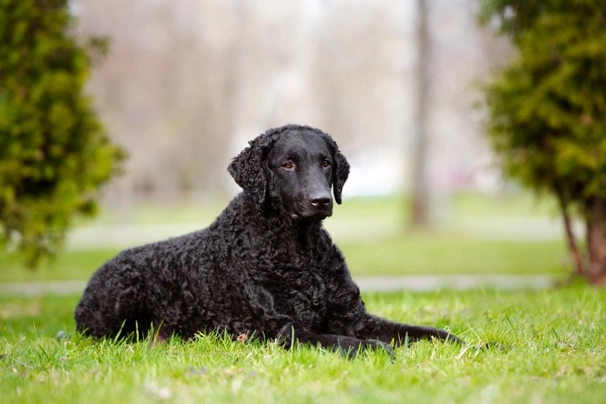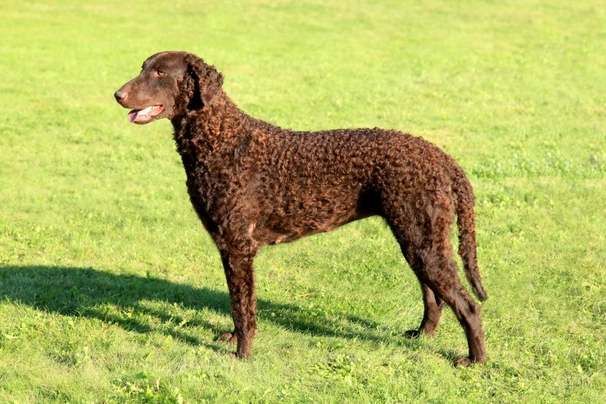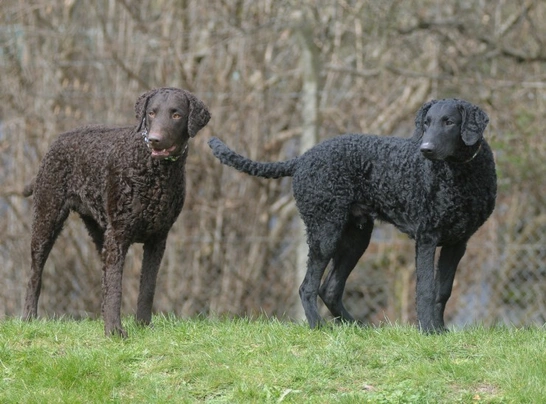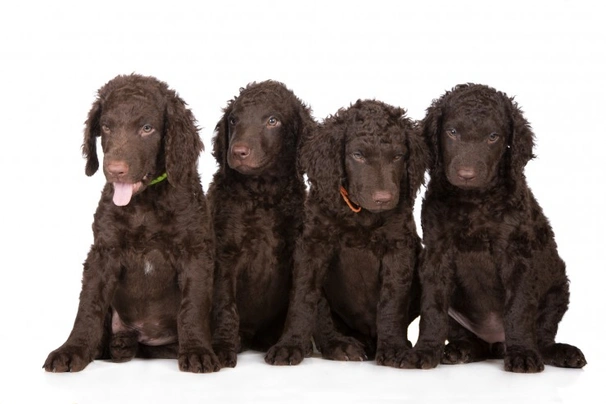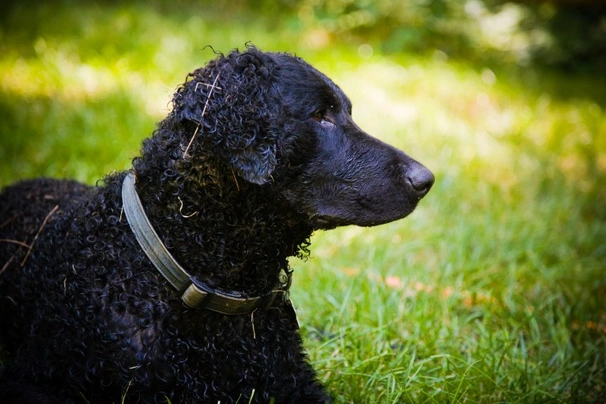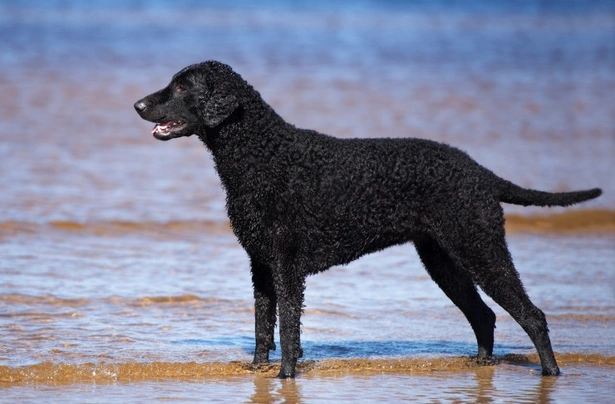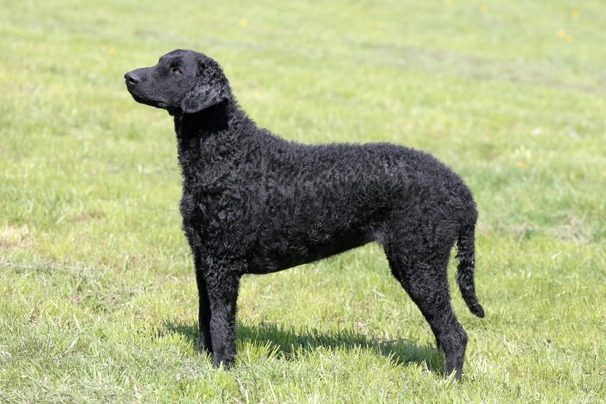Curly Coated Retriever
Pros
Cons
Introduction of the Curly Coated Retriever
The Curly Coated Retriever stands out with its distinctive coat of tight, crisp curls that provide excellent protection and water resistance, enabling the dog to shake off water quickly and stay dry. Known as one of the oldest retriever breeds, this dog was originally bred for its exceptional skills in retrieving game, particularly in water, a role it continues to embrace today alongside being a loyal family companion. Its striking appearance combined with a gentle, affectionate nature makes it a popular choice for those seeking a versatile and devoted pet. However, this breed best suits owners who have some experience with dogs, as they respond well to firm yet gentle handling.
Physically, the Curly Coated Retriever is large, athletic, and confident, with a sleek muscle tone and a coat that is unique among retrievers, giving them unmistakable charm. Temperamentally, they are intelligent, energetic, and playful, though somewhat independent and late to mature, often not settling until around three years of age. This developmental timeline necessitates patient but consistent training to channel their wilful tendencies constructively.
This breed thrives with active owners who enjoy outdoor activities such as canine sports and water-based games, given their natural affinity for water and high exercise needs. They need ample mental and physical stimulation to remain balanced and happy. Living in a home with a large, secure garden is ideal, as it allows them the freedom to roam safely. They are affectionate with families and good with children who understand respectful dog interaction. In return, the owner must be committed to regular grooming to maintain the signature curly coat and to meeting their ongoing healthcare requirements.
Perfect For
The Curly Coated Retriever perfectly suits families and active individuals who have the time and energy to devote to daily exercise and mental enrichment. It is ideal for those who have prior dog ownership experience, as the breed requires consistent leadership and training patience during its extended maturation period. Enthusiasts of canine sports like agility and obedience will find this breed rewarding, and those living in rural or suburban areas with ample garden space will benefit from the breed's love for outdoor activity.
Key Considerations
Prospective owners must appreciate the dog's independent nature and high prey drive, which means secure containment and careful supervision off-lead are vital. Early socialisation is critical to ensure the Curly matures into a confident and well-adjusted adult, especially given their late development. Grooming is relatively low-maintenance compared to other long-haired breeds but regular brushing and occasional professional trims are necessary to keep the coat healthy. Due to the breed's sensitive ears, diligent ear care post-swimming is important to prevent infections. Lastly, this breed is not recommended for first-time dog owners due to its strong-willed personality and exercise demands.
History of the Curly Coated Retriever
The Curly Coated Retriever's origins are somewhat obscured, but similar curly-coated dogs appear in records dating back to the early 19th century, around 1803. Hailing from the United Kingdom, this breed is believed to be one of the earliest retriever types developed specifically for water fetching. By 1860, the breed was shown in dog shows, signalling its established presence. The first dedicated breed club emerged in 1896, contributing to formalising the breed with a written standard set in 1913.
Early Development
Breeders aimed to develop a hardy and versatile retriever with a waterproof coat, capable in both water and land retrievals. The Curly Coated Retriever's ancestry is thought to include breeds such as the Large Rough Water Dog, Lesser Newfoundland, Tweed Water Spaniel, Irish Water Spaniel, Barbet, Poodle, and the Wetterhound. Wartime disruptions during the First and Second World Wars severely reduced their numbers, compounded by the rising popularity of the Labrador Retriever. Dedicated breeding efforts in the 1930s helped preserve the breed, with multiple exports supporting international survival, especially to Scandinavia, the US, and Australia.
Modern Recognition
The Curly Coated Retriever Club was founded by Frank Till in 1951, fostering community and standardised breeding. The Kennel Club granted the club the authority to organise Championship Shows beginning in 1984. Although once more popular as a family companion in mid-20th century Britain, the breed remains relatively uncommon today with a vulnerable native breed status on the Kennel Club list. Enthusiasts maintain steady breeding programmes, despite the limited annual registrations. Well-bred Curlies can command high prices, reflecting their rarity and desirability.
Appearance of the Curly Coated Retriever
Size and Build
Males stand between 64 and 69 cm at the withers and weigh 32 to 41 kg, while females range from 58 to 64 cm in height, weighing 23 to 32 kg. The breed displays a muscular, athletic build with a balanced and strong frame. Their bodies are deep-chested with well-sprung ribs extending well back, powerful loins, and slightly tucked-up flanks. The topline is level and sturdy, supported by strong, straight forelegs and muscular hindquarters. This combination ensures efficient, effortless movement and stamina in fieldwork.Coat and Colours
The hallmark of the breed is its dense, weather-resistant coat of tight, crisp curls tightly covering the body from the occiput to the tail tip without an undercoat. The only recognised colours by the Kennel Club are Black and Liver (dark brown), though these are sometimes subject to subtle shade variations. This coat protects from cold and wet conditions and has the unique property of water repellence which facilitates their retrieving and swimming abilities.Distinctive Features
The head is wedge-shaped with a slight stop, featuring a strong muzzle and a perfect scissor bite. The nose colour matches the coat, being black or brown. Eyes are large, oval, and obliquely set, coloured black or brown to harmonise with the coat. Ears are relatively small, set just above eye level, close to the head, and covered in fine curls. The tail is set on to flow in line with the topline and is carried straight and level when alert or moving. Their gait is smooth and powerful, with good reach and drive, and the legs tend to converge somewhat at speed.Gender Differences
Males are generally larger and more robust, with slightly coarser coats, while females tend to be lighter and more refined in appearance. Male Curlies shed their coat once yearly, whereas females shed twice a year. Temperamentally, males may exhibit a bit more independence and wilfulness, particularly during the prolonged maturation phase, while females can be somewhat more amenable and steady.Temperament of the Curly Coated Retriever
The Curly Coated Retriever is renowned for its good-natured and loyal temperament, embodying a calm yet spirited personality. These dogs are intelligent and eager to please, making them responsive to training when handled with consistent, firm, yet gentle leadership. However, their late maturity, often reaching full behavioural adulthood at around three years, means they can display wilful and independent tendencies during adolescence. Patience and consistency are key to unlocking their best behaviour.
Core Personality Traits
Curlies are playful and energetic with a sense of humour, delighting in interactive games and participating eagerly in canine sports such as agility and obedience. They form strong bonds with their families and are affectionate, especially when socialised from a young age. They tend to be standoffish rather than aggressively confrontational with strangers, often observing cautiously before engaging.
Social Behavior
While wary of unfamiliar people, Curlies rarely display aggression, preferring to keep their distance. Their socialisation with other dogs is usually positive when started early, and they generally coexist well with other pets in the household if introduced properly. Their high prey drive, inherited from working and hunting ancestry, requires supervision around smaller animals such as cats or wildlife to prevent chasing.
Working Instincts
As a breed bred for retrieving and water work, the Curly has strong natural instincts for tracking, retrieving, and swimming. Their enthusiasm for water is a defining characteristic, and they thrive on jobs or activities that simulate field work. If these instincts are not satisfied, they can become bored or destructive.
Common Behavioral Challenges
Curlies can be somewhat stubborn and independent, which requires training approaches that maintain their interest and motivation. They have a low boredom threshold and can become vocal, particularly alert barking when strangers approach, though this is seldom excessive. Their strong prey drive and wilful nature mean they need firm boundaries and continued socialisation and obedience training. Without sufficient mental and physical exercise, behavioural issues such as destructiveness and separation-related stress may emerge.
Intelligence / Trainability of the Curly Coated Retriever
Curly Coated Retrievers are intelligent and generally eager to please, making them good candidates for training when approached correctly. Their sensitivity to handling means that training should always be firm but fair, ensuring the dog understands expectations without feeling intimidated. Consistency from early socialisation through adulthood is critical due to their prolonged adolescent phase.
Puppy Training Priorities
During the first six months, focus should be on establishing clear boundaries, socialising with a variety of people, animals, and environments, and teaching essential basic commands such as ‘come’, ‘sit’, ‘stay’, ‘heel’, ‘quiet’, ‘leave it’, ‘down’, and ‘bed’. Avoid overindulgence despite their cute puppy phase to prevent habit formation of wilfulness. Early mental stimulation and varied exercises help keep their attention and foster good behaviour.
Training Methods That Work
Positive reinforcement using treats and praise is effective, complemented with play to keep sessions engaging. Repetitive or dull training can cause the breed to lose interest quickly. A mix of formal obedience lessons and interactive games helps maintain motivation. Incorporating water-related activities and agility can cater to their natural instincts and physical energy.
Advanced Training Potential
Due to their working heritage and intelligence, Curly Coated Retrievers can excel in advanced obedience, agility competitions, and field trials. They are also suited to search and rescue and other working roles that utilise their retrieving drive and stamina.
Common Training Mistakes
Inconsistency or overly harsh training techniques can lead to resistance or anxiety. Ignoring their need for mental stimulation risks behavioural issues. Allowing too much freedom too early off-lead without reliable recall can be dangerous due to the prey drive. Overly repetitive training sessions should be avoided.
Children and other
When properly socialised and trained from an early age, the Curly Coated Retriever is affectionate and generally excellent with children. Their gentle nature makes them good companions for kids, but due to their size and strength, interaction should always be supervised to prevent accidental rough play that could lead to injuries. Teaching children to respect the dog’s boundaries and signals is essential for a harmonious household.
Age-Specific Interactions
With toddlers and very young children, careful supervision is necessary as Curlies can unintentionally be too boisterous given their playful energy and size. Older children and teenagers often relish the active companionship these dogs offer, enjoying outdoor games and training activities together. Curlies tend to bond strongly with family members, showing patience and tolerance.
Teaching Children Proper Interaction
It is vital that children learn to approach the dog calmly, avoid sudden movements, and not disturb the dog while eating or resting. Encouraging gentle petting and understanding the dog’s body language supports safe, positive interactions. Adults must model and enforce boundaries clearly.
Breed-Specific Considerations
Though loving and patient, Curlies’ large size and power necessitate cautious management to ensure children and dogs remain safe. Their energetic nature means children should be prepared for an active dog needing daily exercise and mental stimulation. Early training helps moderate their playfulness.
Creating Safe Environments
Supervision is critical during all child-dog interactions, especially with young children. Providing the dog with a safe retreat area where it can relax undisturbed is beneficial. Families should educate themselves about the breed’s characteristics to foster a nurturing environment that meets both child and dog needs.
Health of the Curly Coated Retriever
The Curly Coated Retriever has a life expectancy averaging 12 to 13 years when provided with proper care and nutrition. While generally robust, this breed does face a set of hereditary health challenges that prospective owners should be aware of to ensure early detection and management.
Breed-Specific Health Conditions
Common conditions observed in the breed include hip and elbow dysplasia, which can affect mobility, necessitating regular veterinary screening. Progressive retinal atrophy (PRA) affects vision and requires annual testing. Exercise Induced Collapse (EIC), glycogen storage disease type IIIa (GSD IIIa), cataracts, cancer, bloat (gastric torsion), epilepsy and seizures, renal failure, entropion, distichiasis, various allergies, alopecia, and canine follicular dysplasia are also reported concerns.
Genetic Testing Requirements
Responsible breeders adhere to rigorous health testing protocols, including the BVA/KC hip and elbow dysplasia schemes, annual PRA screening, and DNA tests for EIC and GSD IIIa. These efforts aim to minimise hereditary health risks and improve breed longevity.
Preventive Healthcare Schedule
Puppies receive initial vaccinations prior to sale, followed by recommended booster shots at 10 to 12 weeks and beyond. Discussions with a vet about ongoing vaccination schedules ensure optimal disease protection. Additionally, spaying or neutering is advised between six and twelve months of age to promote health and behavioural benefits.
Insurance Considerations
Given the breed’s predisposition to several hereditary conditions, comprehensive pet insurance is advisable. Insurance premiums vary based on age, location, and neuter status, but having cover can significantly offset high veterinary expenses, particularly for conditions requiring ongoing treatment or surgery.
Caring for the Curly Coated Retriever
Daily care for a Curly Coated Retriever involves a structured routine balancing exercise, grooming, feeding, and health monitoring. Mornings might start with a gentle walk followed by breakfast and a brief play session. Afternoons should include longer, varied walks or canine sports sessions to satisfy both physical and mental needs. Evenings are suitable for quieter activities, such as cuddling and grooming.
Living Environment Needs
This breed flourishes in environments offering space and security, like homes with large, securely fenced gardens. They are less suited to apartment living or environments lacking outdoor access due to their exercise requirements and exuberance. Climate moderation is crucial, with protection from extreme weather conditions recommended.
Seasonal Care Adjustments
During summer, owners must attend to hydration and shelter from heat, avoiding vigorous exercise during peak temperatures. Winter care includes coat maintenance and ensuring warmth, especially since their coat provides excellent protection but older dogs may require additional support.
Senior Care Adaptations
As the dog ages, diets should be adjusted to lower calories and tailored nutrients for joint health and weight control. Reduced exercise intensity is recommended alongside enhanced comfort measures such as orthopaedic beds, mobility aids, and more frequent vet visits to monitor health declines.
Grooming of the Curly Coated Retriever
The Curly Coated Retriever's dense curly coat is relatively low maintenance compared to many other breeds with long hair. Weekly brushing using a soft slicker brush effectively prevents tangles and mats. Because their coat is water and weather-resistant, dirt and mud typically do not adhere strongly, reducing the need for frequent baths.
Coat Maintenance Schedule
Owners should incorporate a weekly grooming routine dedicating about 20 to 30 minutes to brushing and coat inspection. Occasional professional trims, perhaps every few months or as needed, help manage length and maintain a tidy appearance.
Professional Grooming Requirements
Professional grooming is usually only necessary if the coat becomes excessively long or if the owner prefers a neater presentation. Costs vary regionally but typically range from £30 to £60 per session, depending on salon and specific services requested.
Home Grooming Techniques
Home grooming requires basic tools such as a slicker brush, grooming gloves, and scissors with rounded ends for trimming stray hairs. Regular ear checks and cleaning are essential to prevent wax buildup and infections due to the breed's susceptibility. Nail clipping, teeth brushing with dog-specific toothpaste, and occasional bathing with dog-formulated shampoo complete the care routine.
Common Grooming Challenges
Owners should watch for mats forming behind ears or in tail areas, which can become uncomfortable if untreated. Seasonal shedding is minimal but males shed once per year and females twice; timely grooming helps manage loose hair. Ear infections are a concern, particularly after swimming, so thorough drying and regular inspection are important.
Exercise of the Curly Coated Retriever
The Curly Coated Retriever is a high-energy breed requiring at least two hours of exercise daily, including both physical activity and mental stimulation. Morning walks can be shorter but should be supplemented by a longer, more engaging afternoon or evening session that may include swimming since the breed adores water. Daily access to a secure garden encourages free roaming and additional activity.
Suitable Activities
Activities such as obedience training, agility courses, flyball, and retrieving games are well-suited for this breed. Swimming not only satisfies their natural instincts but also provides joint-friendly exercise. Puzzle toys and training games stimulate their sharp minds, preventing boredom.
Exercise Restrictions
Puppies must not be over-exercised to protect growing joints and bones. They should be prevented from jumping excessively, running on hard surfaces, and climbing stairs frequently during their first year. Weather considerations include avoiding intense exercise in extreme heat or cold to safeguard their health.
Mental Stimulation Ideas
Including training sessions, scent work, and interactive toys in their routine satisfies their intelligence and prevents destructive behaviours resulting from boredom. Changing games regularly keeps them engaged and eager to learn.
Feeding of the Curly Coated Retriever
Curly Coated Retriever puppies should be fed a high-quality, nutritious diet specially formulated for growth, divided into three to four meals daily, gradually reducing to two meals by adulthood. A gradual diet transition is essential to avoid digestive upset. Adult Curlies require balanced, nutrient-rich food with sufficient protein (around 20-25%) and moderate fat content to maintain energy levels without excess weight gain.
Nutritional Requirements
The ideal diet supports sustained energy release and joint health, including omega fatty acids and glucosamine supplements as needed. Attention should be given to appropriate calcium and phosphorus levels, particularly during puppy development. High-quality protein sources and low fillers, avoiding excessive grains, support coat and overall health.
Feeding Schedule Guidelines
Adults typically feed twice daily, with protein and calorie needs adjusted based on activity. Treats should be limited and healthy, integrated into training routines without exceeding daily caloric needs.
Special Dietary Considerations
Given the breed's susceptibility to bloat, feeding multiple smaller meals and avoiding exercise immediately before and after eating are vital. Elevated feeder bowls can aid in comfortable feeding positions. Allergy sensitivities require monitoring and consultation with a vet for appropriate diets or hypoallergenic food.
Weight Management
Regular weight checks and body condition scoring help maintain ideal weight, preventing obesity which contributes to joint stress and reduces lifespan. A lean physique with a visible waist and palpable ribs is optimal.
Curly Coated Retriever price
If you are looking to buy a Curly Coated Retriever you may have to go on a waiting list because not many puppies are registered with The Kennel Club every year and you would need to pay anything from £800 to over £1,500 for a well-bred pedigree puppy. The cost of insuring a male 3-year-old Curly in northern England would be around £24 a month for basic cover but for a lifetime policy this would set you back roughly £50 a month (quotes current as of 2025). When insurance companies calculate a pet's premium they factor in several things including where you live in the UK and a dog's age and whether they have been neutered or spayed among other criteria.
When it comes to food costs you need to buy the best quality food whether wet or dry to feed your dog throughout their lives making sure it suits the different stages of their lives. This would set you back between £50 - £60 a month. On top of this you would need to factor in veterinary costs if you want to share your home with a Curly and this includes their initial vaccinations, their annual boosters, the cost of neutering or spaying your dog when the time is right, and their yearly health checks, all of which quickly adds up to over £1000 a year.
As a rough guide the average cost to keep and care for a Curly Coated Retriever would be between £80 to £110 a month depending on the level of insurance cover you opt to buy for your dog but this does not include the initial cost of buying a well-bred Kennel Club registered pedigree Curly Coated Retriever puppy. For a selection of Curly Coated Retriever puppies currently available you can find Curly Coated Retrievers for sale on Pets4Homes.
Buying advice
Curly Coated Retrievers are relatively rare and can be challenging to find due to their vulnerable native breed status and low annual registration numbers with the Kennel Club. When searching for a puppy, it’s crucial to buy from an ethical breeder who complies with health testing and breeding standards that prioritise the welfare of the dog and breed preservation. You can find Curly Coated Retriever puppies for sale to start your search.
Finding Ethical Breeders
Look for breeders registered with the Kennel Club Assured Breeder Scheme who perform health testing on all breeding stock, including BVA/KC hip and elbow scoring and PRA screening. Verify the breeder’s premises, see the litter with their mother, and check documentation carefully. Avoid sellers who request payments before meeting the puppies or who have multiple litters too frequently, which can indicate poor welfare standards.
Health Testing Verification
Ensure the breeder provides health certificates proving that parents have undergone screenings for common breed-specific conditions such as hip dysplasia, elbow dysplasia, PRA, and any available DNA tests for Exercise Induced Collapse and Glycogenosis (GSD) type IIIa.
Puppy Selection Process
Evaluate puppy temperament, seeking signs of confidence and sociability rather than fearfulness or aggression. Ask the breeder about early socialisation practices, diet, and vaccinations. Inspect the puppy’s environment and behaviour to ensure they have been well raised.
Contract and Guarantee Review
Carefully read and understand the purchase contract, including clauses about health guarantees, return policies, and breeder support post-sale. Be wary of vague or absent warranties. A reputable breeder will provide a clear contract detailing the responsibilities and rights of both parties.
Rescue and Adoption Options
For those considering adoption, it is possible to find Curly Coated Retrievers through breed-specific rescues or general retriever rescues. This provides an opportunity to give a home to a dog in need while contributing positively to breed welfare.
